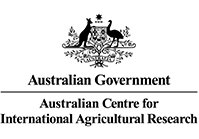
Pacific Pests, Pathogens & Weeds - Mini Fact Sheet Edition
Cassava mealybug (329)

Summary
- Widespread distribution. Southeast Asia, but NOT yet in Oceania. On cassava and relatives. Extremely important in Africa until effective biocontrol.
- Causes loss of leaves (in Africa, cassava used as leafy vegetable), low root yields, and poor cuttings for next crop.
- Sucking of sap causes leaf distortion, leaf fall and shoot dieback. Honeydew falls on leaves resulting in sooty moulds.
- Eggs on shoots, "crawlers" hatch and disperse, settle, moult and become adults covered in pink wax, up to 2.5 mm long.
- Spread by crawlers; they walk, or carried by wind, vehicles, animals, birds, on clothing, or on cuttings.
- Natural enemies: ladybird beetles, and parasioid wasps (e.g., Apoanagyrus lopezi).
- Cultural control: avoid sandy or nutrient-poor soils; apply manure or mineral fertilizer, and use mulch to conserve moisture; hot water - put cuttings in equal amounts boiling and cold water for 5 minutes; collect and destroy debris after harvest; crop rotation (legumes, maize).
- Chemical control: avoid insecticides after release of biocontrol agents. Otherwise, use soap solution, horticultural or white oils (see Fact Sheet no. 56). Only use e.g., synthetic pyrethroids to kill ants.
Common Name
Cassava mealybug
Scientific Name
Phenacoccus manihoti
AUTHOR Grahame Jackson
Information from Herren HR, Neuenschwander P (1991) Biological control of cassava pests in Africa. Annual Review of Entomology 36:257-283; and CABI (2017) Phenacoccus manihoti (cassava mealybug) Crop Protection Compendium. (www.cabi.org/cpc); and from Cassava mealybug (Phenococcus manihoti) Plantwise Knowledge Bank. (http://www.plantwise.org/KnowledgeBank/Datasheet.aspx?dsid=40173). Photos 1-5 Kris Wyckhuys (CIAT) and Phanuwat Moonjuntha (Thai DoA). Photos 6&7 Georg Goergen, IITA-Benin.
Produced with support from the Australian Centre for International Agricultural Research under project PC/2010/090: Strengthening integrated crop management research in the Pacific Islands in support of sustainable intensification of high-value crop production, implemented by the University of Queensland and the Secretariat of the Pacific Community.
This mini fact sheet is a part of the app Pacific Pests, Pathogens & Weeds
The mobile application is available from the Google Play Store and Apple iTunes.




Copyright © 2020. All rights reserved.
 Pacific Pests, Pathogens & Weeds - Mini Fact Sheet Edition
Pacific Pests, Pathogens & Weeds - Mini Fact Sheet Edition